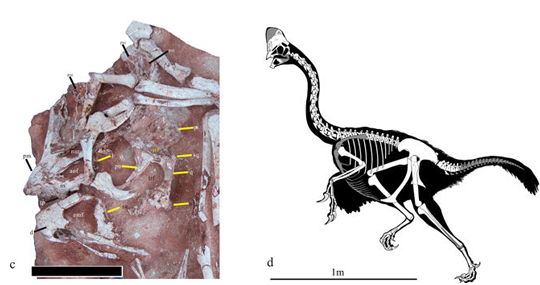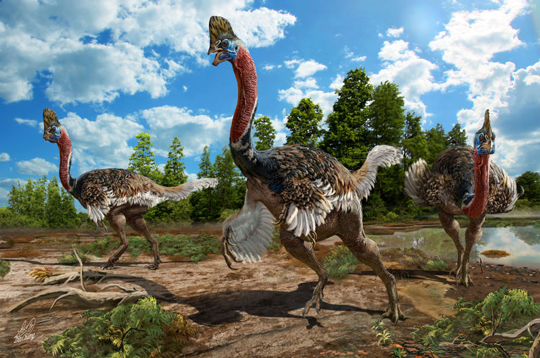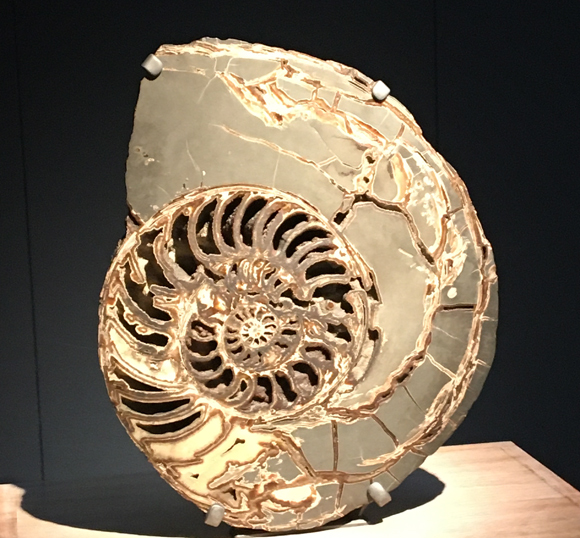Corythoraptor jacobsi – Built Like an Ostrich with the Crest of a Cassowary
Yet another new species of oviraptorid has been named from fossils found in Ganzhou, Jiangxi Province (southern China). This new dinosaur, which was probably feathered, had a longer neck than its oviraptorid contemporaries making it resemble an ostrich. It also possessed a crest on top of its skull, called a casque, which was very similar to that seen in the extant, Australian flightless bird, the Cassowary. This could be a case of convergent evolution between a dinosaur and a non-avian dinosaur.
This new dinosaur has been named Corythoraptor jacobsi, the genus name translates as “helmet speedy thief”, whilst the trivial name honours Professor Louis L. Jacobs of the Southern Methodist University, (Dallas, Texas, USA), who acted as a mentor to three of the authors of the scientific paper, published in the journal “Scientific Reports”.
An Illustration of the Newly Described Oviraptorid from Southern China (Corythoraptor jacobsi)
Picture credit: Zhao Chuang
The Magnificent Seven
The naming of Corythoraptor brings the total of Late Cretaceous oviraptorids known from this part of China to seven. All seven oviraptorids come from the Nanxiong Formation which relates to the Late Campanian/Early Maastrichtian faunal stages of the Late Cretaceous, around 73 – 71 million years ago.
Palaeontologists are uncertain as to why this part of China seems to have been a “hot spot” for oviraptorosaurs, the palaeoenvironment might have favoured these cursorial theropods, which are believed to have been omnivorous, or this type of dinosaur may simply be under represented in other Upper Cretaceous deposits elsewhere in the world.
Intriguingly, of the seven oviraptorid dinosaurs named to date some are known to have been crested and different shaped crests have been identified. All these dinosaurs are approximately the same size, around two metres in length and all of them were probably feathered. The long neck (twice as long as the dorsal vertebral column), of Corythoraptor might have evolved to permit this dinosaur to exploit a food source that its contemporaries could not, in the same way that many modern-day antelopes on the African savannah have different neck lengths to help them browse on different plants – an example of niche partitioning.
The Crest of Corythoraptor

The cranial casque of Corythoraptor. Fossil material (a), line drawing (b) and colour restoration (c).
Picture credit: Scientific Reports
The Seven Oviraptorids from the Nanxiong Formation (to date)
The Seven Oviraptorids from the Nanxiong Formation (so far) – green text indicates information on crests (casques)
- Banji long (named and described in 2010) small, flat crest.
- Ganzhousaurus nankangensis (named and described in 2013) with a potentially, slightly raised crest.
- Jiangxisaurus ganzhouensis (named and described in 2013) potentially crested – small crest.
- Nankangia jiangxiensis (named and described in 2013) insufficient fossil material to establish a crest being present.
- Huanansaurus ganzhouensis (named and described in 2015), potentially crested (top part of the skull is missing, but in a phylogenetic analysis carried out by the authors, Huanansaurus was found to be the sister taxon to the newly described Corythoraptor jacobsi. H. ganzhouensis skull material is insufficient to conclusively prove the presence of a crest although the thickened naris and parietal indicate that a crest is likely.
- Tongtianlong limosus (named and described in 2016), it possessed a small crest.
To read a previous article on the discovery of an oviraptorid Huanansaurus (Huanansaurus ganzhouensis), which is believed to be very closely related to Corythoraptor: 2015 – New Oviraptorid Dinosaur from the Late Cretaceous of Southern China.
A Close View of the Skull and Jaws with a Line Drawing of Corythoraptor

A close up of the skull, jaws and the head crest of Corythoraptor with a line drawing showing body plan.
Picture credit: Scientific Reports
The picture above shows a close-up of the skull, crest and jaws of the holotype material, accompanied by a line drawing showing the estimated size and Corythoraptor and what it probably looked like.
The scale bar in (c) is 8 centimetres and the scale bar in (d) is 1 metre. Note that the shape of the crest is inferred, as the actual portion of the skull that represents the majority of the proposed crest is not present, only the lower portion of the bony core of the casque (crest) is preserved. The preserved portion of the nasals exhibits highly pneumatised bone structure. The suture between the parietal and frontal is not clear, but it seems the bones project dorsally and formed a distinct crest together with the nasals, very reminiscent of the crest shape seen in living, non-avian dinosaurs, the Cassowaries.
What were the Crests (Casques) used for?
Lead author of the study, Junchang Lü (Chinese Academy of Geological Sciences), proposes studying the living Cassowary to help shed light on the functional role played by the casque. This could represent an example of convergent evolution, where a similar physical character has evolved independently in two, unrelated species. A study of the fossilised bones suggest that this specimen represents an immature individual, a sub-adult Corythoraptor that may have been around eight years of age when it met its demise. The casque may not have been fully formed when it died, but its function remains a mystery. However, such a prominent casque could have served a multitude of purposes, just like the crest of the Cassowary.
Crest (Casque) Function
- With lots of different oviraptorids living in the same habitat, the crest could have played a role in species recognition (interspecific recognition).
- The crest could have been used in visual communication, in displays to determine social hierarchy or perhaps in ritualised displays over mate selection (intraspecific combat).
- Crest shape could have indicated maturity, with crest shape changing as the animal became older.
- The crest (or casque) could have indicated fitness for breeding during the mating season.
- This structure could have played a role in helping to differentiate between males and females (sexual dimorphism).
- The crest (or casque) shape in oviraptorids could represent the evolution of character as part of sexual selection.
For an article describing the discovery of T. limosus: Stuck in the Mud Dinosaur and Oviraptorosaur Diversity.
Links to the Dinosaurs of China Exhibition at Wollaton Hall (Nottinghamshire)
Readers in the UK, have the opportunity to get up close to a number of Chinese feathered dinosaurs including a specimen of Oviraptor (O. philoceratops) and a giant relation of the oviraptorids, the giraffe-sized Gigantoraptor, at the Dinosaurs of China exhibition in Nottingham. In addition, the superb illustrations found throughout this exhibition and seen at the nearby Nottingham Lakeside Arts Centre, were created by Zhao Chuang, who was responsible for illustrating Corythoraptor in the scientific paper (illustration is seen at the top of this article).
For figures and replicas of feathered theropods: Dinosaur and Prehistoric Animal Models.








Thank you so much for your kindly share? Could the Oviraptor be a close relative to the ostrich? Or Do they live in Mongolia?
I heard some people say all the oviraptor species described from the same place you said above are all the same one species. Is this a possibility?
Whilst the taxonomy of these oviraptorids can always be debated, many of the oviraptorid genera have comparable parts of their skeleton (including the skull bones). Differences in these traits (autapomorphies) has enabled palaeontologists to confidently assign a number of new taxa. Not all the bones come from the same stratigraphic level in the Nanxiong Formation and this also suggests that a number of genera are represented.
Thank you for your comment.